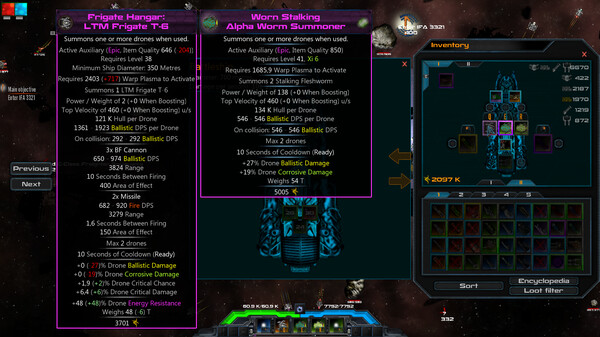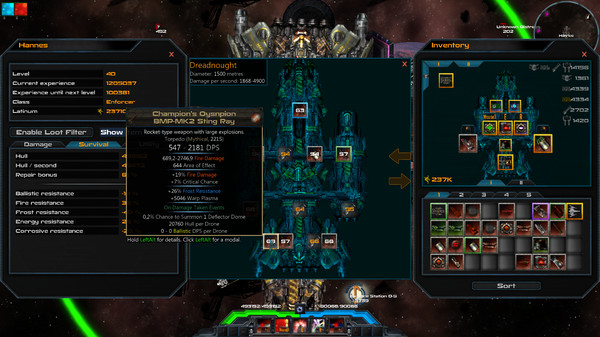Nienix: Cosmic Warfare is a space action RPG that blends top-down shooting, physics-based combat, and looter mechanics into a surprisingly deep and replayable package. Developed and published by HolmCom, it positions itself somewhere between a bullet-hell twin-stick shooter and a Diablo-style action RPG, all set in a procedurally generated galaxy teeming with factions, enemies, and loot. While the indie roots show in certain areas, especially visually and in narrative presentation, the game makes up for it with robust gameplay systems, smart design decisions, and a ton of customization for players who enjoy experimenting with builds and weapons. The premise is straightforward: you're a pilot in a vast galaxy, hunting down the mythical artifact known as Nienix. The story, while serviceable, largely exists to give context to your travels across the stars. You’ll interact with various factions, take on missions, and uncover hints of lore, but the game is far more concerned with delivering intense, moment-to-moment action than it is with spinning a detailed narrative. The tone is generally light, and while there are occasional bits of dialogue or backstory, it’s clear that the gameplay is the real focus. Fortunately, that gameplay has a lot going on beneath the surface. Combat is fast, fluid, and physics-driven. Ships are not just stat blocks; their movement has weight, inertia, and requires a bit of finesse. You’ll be dodging projectiles, managing cooldowns, and unleashing powerful attacks in dense, chaotic firefights. What sets Nienix apart is how layered the combat becomes over time. There are hundreds of weapons and ship components to collect, modify, and upgrade. Everything from laser cannons to explosive mines to kinetic blasters is available, each with its own stats and modifiers. Item drops are procedurally generated, with affixes and tiered rarity that will be familiar to fans of loot-based RPGs. You can mix and match modules, weapons, and passive traits to create ships that specialize in raw damage, crowd control, long-range sniping, or tanky brawling. The skill tree system is expansive, allowing for detailed tuning of your playstyle, whether you're flying solo or as part of a team. One of the most appealing aspects of Nienix is the sheer amount of content packed into it. The campaign alone offers 15 to 20 hours of exploration, combat, and progression, and that’s before diving into the higher-difficulty Continuum mode, which adds a new layer of challenge and additional loot tiers. The game is also fully playable in co-op for up to six players, which transforms the experience significantly. Coordinated teams can build synergies, combining support builds with high-damage loadouts to take on tougher encounters. PvP modes are also available, offering classic deathmatch and team-based battles for those who want a more competitive angle. This flexibility in how you play—solo, co-op, or PvP—makes it a versatile game with solid replay value. Visually, Nienix does what it needs to do. The graphics are clean and functional, though clearly developed with performance and clarity in mind rather than visual spectacle. The top-down perspective works well for reading enemy patterns and managing your positioning in the chaos of battle. That said, during more intense sequences, the screen can become overwhelmed with particle effects, laser blasts, and explosion debris. This can make it difficult to track projectiles or incoming threats, especially in darker environments or denser fights. It’s not game-breaking, but it does highlight the game’s focus on mechanics over polish. Still, it runs smoothly on a wide range of hardware and has full support for Steam Deck, which is a nice bonus for portable play. The procedural nature of the world brings both benefits and drawbacks. On one hand, it ensures that each playthrough feels fresh, with randomized sectors, missions, and loot keeping things from becoming too predictable. On the other hand, procedural generation can result in repetition, with certain enemy types, mission structures, or environments feeling recycled after extended play. There's also a sense that some regions lack the handcrafted uniqueness seen in more curated games. However, for players who are more interested in experimentation, loot chasing, and emergent combat encounters, the procedural format works well enough to sustain long-term engagement. There are a few rough edges in other areas as well. The user interface, while mostly functional, can feel cluttered when you're deep into build customization or fleet management. Tooltips and menus occasionally lack clarity, especially when comparing items or upgrading parts. The pacing also fluctuates, with certain stretches of the game dragging a bit if you're under-leveled or haven’t found a satisfying gear setup. Grind can set in, particularly at higher difficulties where enemies become bullet sponges and rare loot becomes essential for survival. That said, the game does reward persistence, and the sense of power progression is genuinely satisfying once you start to build a ship that feels uniquely yours. Where Nienix succeeds most is in providing a dense, replayable sandbox for space combat and customization. It may not win awards for visual fidelity or storytelling, but it makes up for that with sheer mechanical depth and player freedom. The ability to create a wide array of ships, experiment with different loadouts, and play either solo or with friends makes it a compelling package for fans of space shooters and loot-driven games. The difficulty curve ramps up significantly in later modes, making it a good fit for players who enjoy fine-tuning their builds and mastering challenging encounters. In the end, Nienix: Cosmic Warfare is a standout title in the indie action RPG space shooter niche. It offers a surprising amount of content and mechanical depth for its price point, and its mix of bullet-hell combat, loot progression, and procedural exploration gives it strong replay value. It won’t be for everyone—particularly those looking for a tightly crafted narrative or cinematic presentation—but for players who enjoy building their own playstyles, chasing gear, and diving into frenetic space battles, it’s a rewarding and underappreciated gem. Rating: 8/10
Expand the review














































